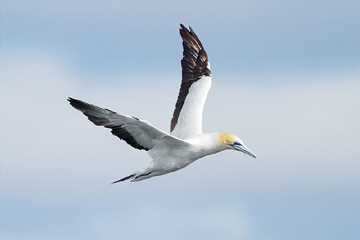The numbers of many species of shorebirds are dwindling — the result of loss of habitat, pollution, and other causes. One exception is the Australasian gannet, which inhabits the shores of New Zealand and southern Australia. In Australia alone, thanks to conservation programs and other efforts, its numbers have tripled since 1980.
 Due to conservation programs, Australasian gannet number are on the rise. Credit: JJ Harrison, Wikipedia
Due to conservation programs, Australasian gannet number are on the rise. Credit: JJ Harrison, WikipediaA mature gannet is about three feet long and has a wingspan of up to five feet. It has a white body with black-tipped wings and a golden head and neck.
Australasian gannets live mostly on rocky islands, although there are a few colonies on the mainland. The birds stage elaborate mating rituals, bobbing their heads up and down and tapping their beaks.
The adults stick close to their colonies, but young chicks can make long migrations. They cross the Tasman Sea between Australia and New Zealand — a range of more than 1500 miles — or cross from one side of Australia to the other — a range of about 2,000 miles.
The gannets are best known for their hunting technique. They hunt in flocks, flying over shallow waters in search of fish and squid. When they find a school, the birds fold their wings and dive from heights of up to a hundred feet or so. They pierce the water like arrows, diving as far as 50 feet below the surface to seize prey with their beaks. They remain below for only a few seconds, but by the time they bob back to the surface they’ve already swallowed their prey. Then it’s back to the air — and another run for a graceful bird that’s made a big comeback.

